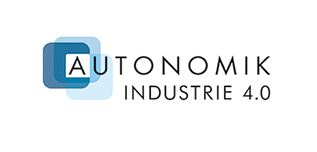Projects
Click here for information about the projects funded. Click the project title to go to the project information.
InSA
Protection and safety concepts for co-operation between humans and robots in joint working areas
Brief description
In the InSA project, previously independent working areas of employees in production and of robot systems are monitored using sensor technology in order to co-ordinate safety precautions. The system records current activities and, taking the context and respective situation into account, assesses the risk potential which a worker, for instance, could be exposed to due to robot movements. The aim of this project is technical standardisation of these context-orientated production systems and their integration into smart production environments, so that the economic efficiency of industrial robots can be improved in mixed working environments.
The challenge
Robots and people will work closely together in the factory of tomorrow. Up to now, robotic and human workplaces have been strictly separated for safety reasons, for instance, using safety fences. However, if they were to co-operate closely this would promote efficient and smooth production. And when man and machine work together today, the robot stops immediately as soon as a dangerous situation is detected. The consequence of this is that production slows down or comes completely to a halt. What's needed are new protection concepts that permit close interaction by both players and keep disruptions in operations to a minimum.
Aim
As part of the InSA project, researchers are working on a comprehensive protection model that includes the user of a robot and his context, his environment, his activities and interaction. The system records current activities and, taking the context and respective situation into account, assesses the risk potential which a worker, for instance, could be exposed to due to robot movements. The aim of this project is technical standardisation of these context-orientated production systems and their integration into smart production environments, so that the economic efficiency of industrial robots can be improved in mixed working environments.
Technologies
This is being made possible by smart interaction between different sensor systems (magnetic field sensors, stereo cameras, laser scanners, RFID, touch sensors). The worker is fitted here with special sensor clothing and detected in the room by stereo cameras and laser scanners. Using this information, the system calculates the risks and triggers protective measures, for instance, by causing a heavy robot arm to retract when a worker is located dangerously close to the robot. Similarly, tools, such as welding devices, are used differently by the robot, speed is controlled and movement sequences are changed in the interest of safety. The top priority here is to keep workers safe at all times. In some ways, the protection mechanisms must predict what could happen.
The project also goes beyond secure man-machine interaction and also addresses work process design and the acceptance of robots working directly with people. At the same time, standardised software architectures and existing communication and interoperability standards are to be used as far as possible in order to keep the new protection concepts as simple as possible and to integrate them into legacy systems.
Use case
The new protection concepts will be demonstrated in two scenarios. In the first scenario, workers and robots will work closely together in assembly where the worker assembles and passes on the prefabricated parts to the robot for further assembly. In this case, the work areas of the worker and the machine overlap so that reliable protection systems are vital. The second scenario is geared to maintenance of industrial systems. In this case, the assembly worker enters the work area of industrial robots where man-robot co-operation is not normally foreseen. This results in a far greater potential for risks than the first scenario, however, these risks have a limited time span.
In order to make production as efficient as possible in both scenarios, the robot should never have to stop nor should its work be excessively restricted. This is where the worker's sensor-fitted clothing comes into its own because thanks to the sensors installed at the workplace the worker's precise movements and position can be detected. The robot responds to this information so that its colleague, the worker, is not injured.
Partners: neusta mobile solutions GmbH (consortium leader), Hubert Schmitz GmbH, ThyssenKrupp System Engineering GmbH, Universität Bremen
More information
- Recommend this page:
- Print view
